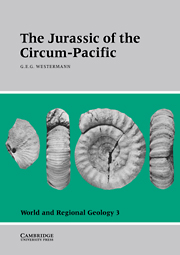Book contents
- Frontmatter
- Contents
- List of contributors
- Preface
- Acknowledgments
- Introduction
- Part I Time scales
- Part II Circum-Pacific base map
- Part III Regional geology and stratigraphy
- 4 Western Canada and United States
- 5 Meso-America
- 6 Western South America and Antarctica
- 7 Australasia
- 8 Indonesia and Papua New Guinea
- 9 Southeast Asia and Japan
- 10 Eastern China
- 11 Eastern Russia
- Part IV Biochronology
- Part V Biogeography
- Part VI Climatology and oceanography
- Appendix: Biochronology and atlas with index and guide fossils
- General Index
- Index of Guide- and Indexfossils
7 - Australasia
Published online by Cambridge University Press: 04 August 2010
- Frontmatter
- Contents
- List of contributors
- Preface
- Acknowledgments
- Introduction
- Part I Time scales
- Part II Circum-Pacific base map
- Part III Regional geology and stratigraphy
- 4 Western Canada and United States
- 5 Meso-America
- 6 Western South America and Antarctica
- 7 Australasia
- 8 Indonesia and Papua New Guinea
- 9 Southeast Asia and Japan
- 10 Eastern China
- 11 Eastern Russia
- Part IV Biochronology
- Part V Biogeography
- Part VI Climatology and oceanography
- Appendix: Biochronology and atlas with index and guide fossils
- General Index
- Index of Guide- and Indexfossils
Summary
AUSTRALIAN REGION
As part of the joint Bureau of Mineral Resources (BMR) and Australian Petroleum Industry Research Association (APIRA) Palaeogeographic Maps Project (Cook 1988), environmental reconstructions have been prepared for Australia for ten Jurassic time slices (Bradshaw and Yeung 1990). Some of the results of this work have been reported by Bradshaw et al. (1988) and by Struckmeyer, Yeung, and Bradshaw (1990), and the following relies heavily on those compilations.
The BMR-APIRA Jurassic paleogeographic maps were compiled from well and outcrop information for both onshore and offshore Australia. The “compromise time scale” (Chapter 1) was used, and correlation was based on the palynological zonation of Helby, Morgan, and Partridge (1987). Figure 7.1 shows the distribution of Jurassic rocks in Australia. There was a thin but extensive platform cover spread across the continent through the Eromanga and adjacent basins, and the thickest depocenters were along the western margin (Barrow-Dampier Subbasin and Perth Basin) and to the east (Clarence-Moreton Basin) and north (Papuan Basin). Marine to fluviodeltaic deposition occurred along the western and northern margins of the continent that bordered Tethys, and nonmarine sequences were deposited in eastern Australia. Deposition was initiated in a terrestrial rift-valley system along the southern margin between Australia and Antarctica. The widespread f luviolacustrine facies attest to a temperate and humid climatic regime. Redbeds are restricted to the Early Jurassic along the western margin, and marine sequences are dominated by elastics, with only rare carbonates.
Australia's Jurassic tectonic regime was dominated by the breakup of Gondwana.
- Type
- Chapter
- Information
- The Jurassic of the Circum-Pacific , pp. 162 - 180Publisher: Cambridge University PressPrint publication year: 1993



